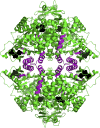Pyruvate kinase: Function, regulation and role in cancer
- PMID: 26277545
- PMCID: PMC4662905
- DOI: 10.1016/j.semcdb.2015.08.004
Pyruvate kinase: Function, regulation and role in cancer
Abstract
Pyruvate kinase is an enzyme that catalyzes the conversion of phosphoenolpyruvate and ADP to pyruvate and ATP in glycolysis and plays a role in regulating cell metabolism. There are four mammalian pyruvate kinase isoforms with unique tissue expression patterns and regulatory properties. The M2 isoform of pyruvate kinase (PKM2) supports anabolic metabolism and is expressed both in cancer and normal tissue. The enzymatic activity of PKM2 is allosterically regulated by both intracellular signaling pathways and metabolites; PKM2 thus integrates signaling and metabolic inputs to modulate glucose metabolism according to the needs of the cell. Recent advances have increased our understanding of metabolic regulation by pyruvate kinase, raised new questions, and suggested the possibility of non-canonical PKM2 functions to regulate gene expression and cell cycle progression via protein-protein interactions and protein kinase activity. Here we review the structure, function, and regulation of pyruvate kinase and discuss how these properties enable regulation of PKM2 for cell proliferation and tumor growth.
Keywords: Cancer metabolism; PKM2; Pyruvate kinase.
Copyright © 2015 Elsevier Ltd. All rights reserved.
Figures



Similar articles
-
Pyruvate kinase M2 isoform deletion in cone photoreceptors results in age-related cone degeneration.Cell Death Dis. 2018 Jul 3;9(7):737. doi: 10.1038/s41419-018-0712-9. Cell Death Dis. 2018. PMID: 29970877 Free PMC article.
-
Pyruvate kinase M2 fuels multiple aspects of cancer cells: from cellular metabolism, transcriptional regulation to extracellular signaling.Mol Cancer. 2018 Feb 19;17(1):35. doi: 10.1186/s12943-018-0791-3. Mol Cancer. 2018. PMID: 29455645 Free PMC article. Review.
-
PKM2 tyrosine phosphorylation and glutamine metabolism signal a different view of the Warburg effect.Sci Signal. 2009 Nov 17;2(97):pe75. doi: 10.1126/scisignal.297pe75. Sci Signal. 2009. PMID: 19920249
-
A short review on cross-link between pyruvate kinase (PKM2) and Glioblastoma Multiforme.Metab Brain Dis. 2021 Jun;36(5):751-765. doi: 10.1007/s11011-021-00690-y. Epub 2021 Mar 2. Metab Brain Dis. 2021. PMID: 33651273 Review.
-
Pyruvate kinase M2 at a glance.J Cell Sci. 2015 May 1;128(9):1655-60. doi: 10.1242/jcs.166629. Epub 2015 Mar 13. J Cell Sci. 2015. PMID: 25770102 Free PMC article. Review.
Cited by
-
Baicalein suppresses inflammation and attenuates acute lung injury by inhibiting glycolysis via HIF‑1α signaling.Mol Med Rep. 2025 Jan;31(1):18. doi: 10.3892/mmr.2024.13383. Epub 2024 Nov 8. Mol Med Rep. 2025. PMID: 39513601 Free PMC article.
-
Intratumoral microbiota: a new force in the development and treatment of esophageal cancer.Clin Transl Oncol. 2024 Oct 25. doi: 10.1007/s12094-024-03757-1. Online ahead of print. Clin Transl Oncol. 2024. PMID: 39455494 Review.
-
Adipocyte metabolic state regulates glial phagocytic function.bioRxiv [Preprint]. 2024 Sep 24:2024.09.24.614765. doi: 10.1101/2024.09.24.614765. bioRxiv. 2024. PMID: 39386724 Free PMC article. Preprint.
-
Inhibition of heterogeneous nuclear ribonucleoproteins A1 and oxidative stress reduces glycolysis via pyruvate kinase M2 in chronic thromboembolic pulmonary hypertension.J Transl Int Med. 2023 Mar 19;12(4):437-451. doi: 10.2478/jtim-2022-0051. eCollection 2024 Sep. J Transl Int Med. 2023. PMID: 39360158 Free PMC article.
-
PKM2 regulates metabolic flux and oxidative stress in the murine heart.Physiol Rep. 2024 Sep;12(17):e70040. doi: 10.14814/phy2.70040. Physiol Rep. 2024. PMID: 39256891 Free PMC article.
References
-
- Warburg OH, Posener K, Negelein E. Über den Stoffwechsel der Carcinomzelle. Biochem Z. 1924;152:309–44.
-
- Warburg O. On the origin of cancer cells. Science. 1956;123:309–14. - PubMed
-
- Eigenbrodt E, Glossmann H. Glycolysis – one of the keys to cancer? Trends Pharmacol Sci. 1980;1:240–5.
-
- Eigenbrodt E, Reinacher M, Scheefers-Borchel U, Scheefers H, Friis R. Double role for pyruvate kinase type M2 in the expansion of phosphometabolite pools found in tumor cells. Crit Rev Oncog. 1992;3:91–115. - PubMed
Publication types
MeSH terms
Substances
Grants and funding
LinkOut - more resources
Full Text Sources
Other Literature Sources
Miscellaneous


